Why Is My Bissell Vacuum Not Suctioning
This post contains affiliate links. As an Amazon Associate, we earn from qualifying purchases.
If your Bissell vacuum isn’t suctioning, the issue is often a simple fix like a clog or a full dust bin. Start by checking the hose and base for blockages, emptying the bin if it’s over two-thirds full, and cleaning the filters or brush roll. Stay tuned for more detailed tips and tricks to get your vacuum back in top shape!
Essential Facts in 30 Seconds
- Clogged filters can reduce suction; clean pre-motor filters every three months.
- A full dirt tank decreases suction; empty it regularly before it’s full.
- Blockages in hoses or air paths cause suction loss; inspect and clear them.
- Worn gaskets or seals can lead to air leaks; check and replace if needed.
- If suction issues persist after cleaning, seek professional help for motor or electrical problems.
Common Reasons for Suction Loss in Bissell Vacuums
Your Bissell vacuum mightn’t pick up dirt well anymore. Don’t stress, many face this issue.
Clogged filters often cause suction loss. Dirty pre-motor filters block airflow big time. Clean them every three months for best results. A musty smell means clean it now! Regular cleaning of the pre-motor and post-motor filters is essential to ensure optimal suction and prevent overheating.
A full dirt tank also kills suction power. Empty it often to keep airflow strong. Make sure the tank fits tight, no leaks. Regular maintenance of filters and hoses can prevent these issues (regular filter maintenance).
Worn gaskets or seals can mess things up too. Check them for cracks or damage. Fix those sneaky air escapes fast.
Studies show 70% of vacuum issues come from clogs. You can solve this, no problem! Keep your vacuum strong and dirt-free.
Checking for Blockages in the Air Path
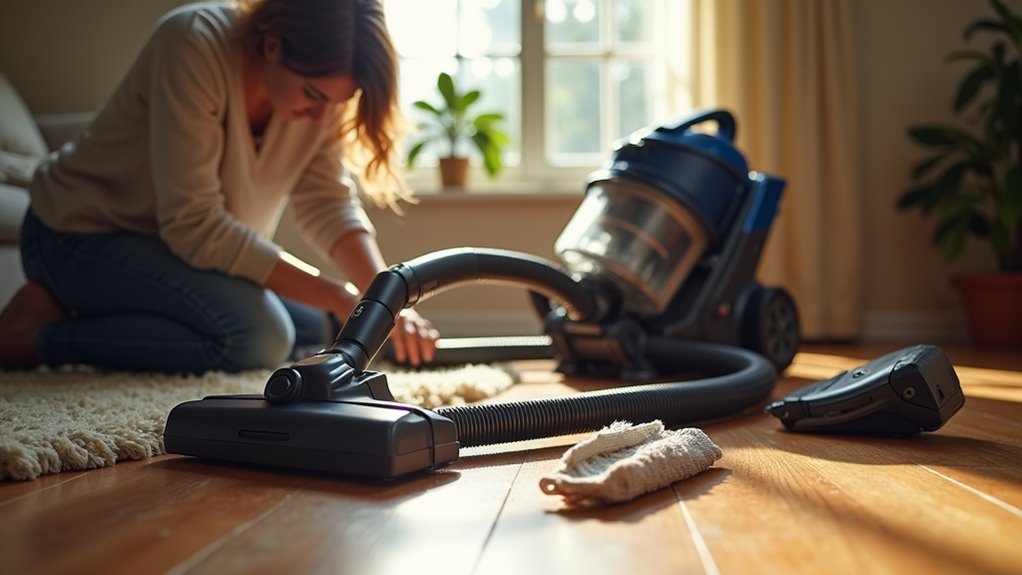
Let’s clear those pesky blockages in your Bissell vacuum right now!
Start with the hose. Shake it well and look inside. See any pet hair or dust stuck there? Remove those sneaky clogs fast.
Then, check the base and intake spots. Clear out debris or tangled messes. Don’t let them hide! For a thorough inspection, use a broom handle to push out potential hose clogs.
Peek at the internal air paths too. Make sure nothing blocks the way. A clean path means better suction. Your vacuum will work like new! Regular cleaning and maintenance are essential to prevent future clogs and maintain optimal suction performance. Dirty filters can also impact suction power, so ensure they are clean or replaced regularly.
Trust me, this simple check helps. Over 80% of suction issues come from clogs. Fix them and see the difference!
Inspect Hose for Clogs
Let’s dive into checking your Bissell vacuum hose for clogs. Clogs often mess up suction power big time.
First, detach the hose from the base and floorhead. This helps you spot problem areas fast.
Next, grab a flashlight and shine it through the hose. Bend it a little to find hidden debris. Pet hair loves to hide inside!
Spot something stuck? Use a long brush to push it out. A cloth-wrapped coat hanger works too. Be gentle so you don’t damage anything.
Put the hose back on after clearing it. Test the suction now. Hear that strong whoosh of air? Nice job! You nailed it!
Clear Vacuum Entry Points
Let’s dive into clearing your vacuum’s entry points for top performance.
Check the intake covers first for hair or dirt buildup. Spot any mess? Grab a soft brush and clean those screens gently. Avoid sharp tools to prevent any damage. Regular maintenance of vacuum filters can greatly enhance efficiency and prolong the lifespan of your vacuum cleaner.
Move to the dustbin next. Is it full? Empty it fast to keep airflow strong. Dust off around the entry spots too. This stops junk from creeping back in.
Make regular checks a habit for awesome suction. Picture it as a fun game—hunting clogs, not treasure! Stick with it. You’ll keep that Bissell power roaring!
Additionally, remember to clean the filters regularly to ensure optimal airflow and maintain suction power, as clogged filters can significantly hinder your vacuum’s performance.
Examine Internal Air Channels
Let’s explore the internal air channels of your Bissell vacuum now. Check for sneaky blockages hiding inside. Unscrew the base plate to look within. Use a flashlight to trace the airflow path. Start from the floor nozzle to the dirt tank. Hunt for any hidden debris along the way. Inspect rubber seals at duct joints closely. Don’t skip the brush roll housing area. Hair often gets stuck there—yep, a real mess! Make sure to also examine the lower hose at the base for potential clogs lower hose clogs. Regular inspection of the brush roll prevents performance issues and ensures that hair and debris do not obstruct airflow. Clogged filters can also restrict airflow, so ensure they are clean and dry.
Take a peek at these key spots:
| Area to Check | Why It’s a Problem |
|---|---|
| Pre-motor filter compartment | Debris loves to hide here! |
| Post-motor exhaust pathways | Dust piles up over time. |
| Secondary accessory ports | Clogs sneak in with attachments. |
Stick with it—you’re doing great!
Importance of Clean Filters for Optimal Performance
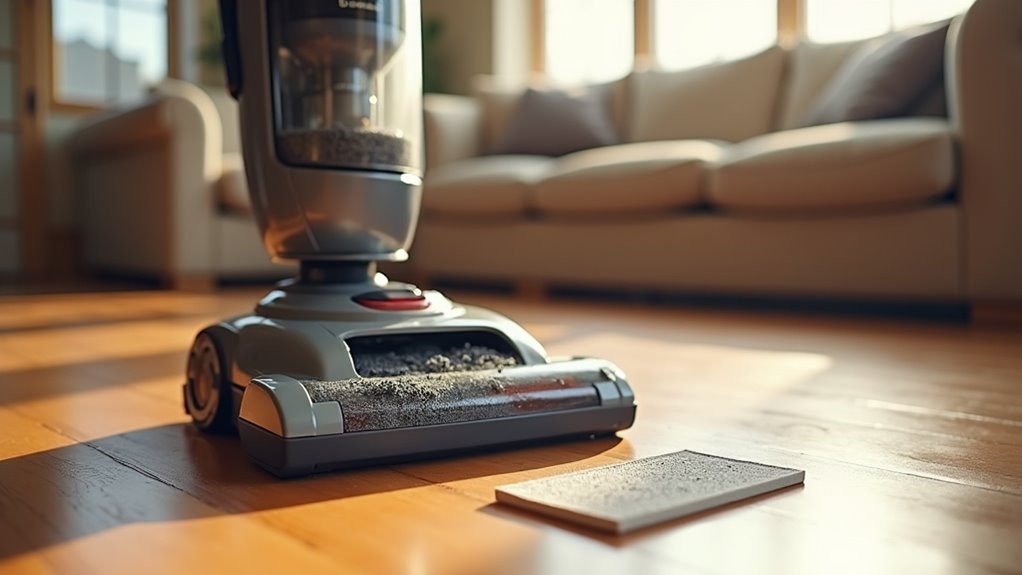
Let’s dive into why clean Bissell vacuum filters matter so much!
Dirty filters block airflow and weaken suction power. Think of it—your vacuum struggles to grab even tiny dirt.
Studies show a clogged filter cuts suction by 30%. Clean filters keep your machine strong and effective.
Check them every month to avoid dust buildup. A quick wash or replacement works like magic.
Trust me, your vacuum will thank you! Stick to this easy habit for top results.
Keep your home spotless with zero hassle!
Filter Cleaning Necessity
Clean filters keep your Bissell vacuum working great every day! They trap dust and tiny allergens like magic. Different filters, such as pre-motor and post-motor, do special jobs. Ignore them, and motor stress might cost you big money—ouch! Mark your calendar to wash filters every three months. Do it sooner if they seem dirty. This easy task stops overheating and blocks mold growth. It also makes home air much cleaner. Think of it as a quick refresh for your vacuum—nice! Grab that filter now, rinse it with care, and dry it fully. Regular maintenance is key to vacuum efficiency and ensures a tidy home for years! Simple steps like these save time and effort. Stick to this routine, and enjoy better vacuum power always! Remember, clogged filters lead to decreased suction power and efficiency, so keeping them clean is essential for maintaining your vacuum’s performance.
Impact on Suction
Clean filters are key to strong suction in your Bissell vacuum. Dirty filters block airflow and hurt performance fast. They make the motor work too hard. This can cause overheating. Clean filters keep suction powerful and grab dust well. Think of it as a clear path for air! Regular maintenance ensures that the vacuum functions effectively and maintains its performance over time. Check pre-motor and post-motor filters for suction issues. Clean ones stop dust from reaching the motor. They help avoid breakdowns. Plus, they lower the noise. A quiet vacuum feels great! Regularly checking and cleaning the brush roll of hair and debris further enhances suction and prolongs the vacuum’s life.
Maintenance Schedule Tips
Keeping your Bissell vacuum in great condition matters a lot. A solid maintenance schedule for filters boosts performance. Match cleaning to your usage—monthly for pet owners. Go quarterly if you use it less. Rinse pre-motor filters every 1-2 months. Don’t ignore post-motor filters on some models. Let them air-dry for 24 hours. Avoid mold and bad smells this way! Good care makes filters last longer. It also prevents motor strain and suction loss. Regularly cleaning your vacuum’s filters traps dust, allergens, and debris, ensuring optimal performance and indoor air quality. Inspect hoses during filter cleaning. Use lukewarm water for rinsing filters. Brush off debris before you rinse. Simple steps keep your vacuum strong. Maintain it well, and it cleans like new!
Regular cleaning of filters is essential for maintaining your vacuum’s efficiency and performance.
Inspecting the Dust Bin for Proper Function
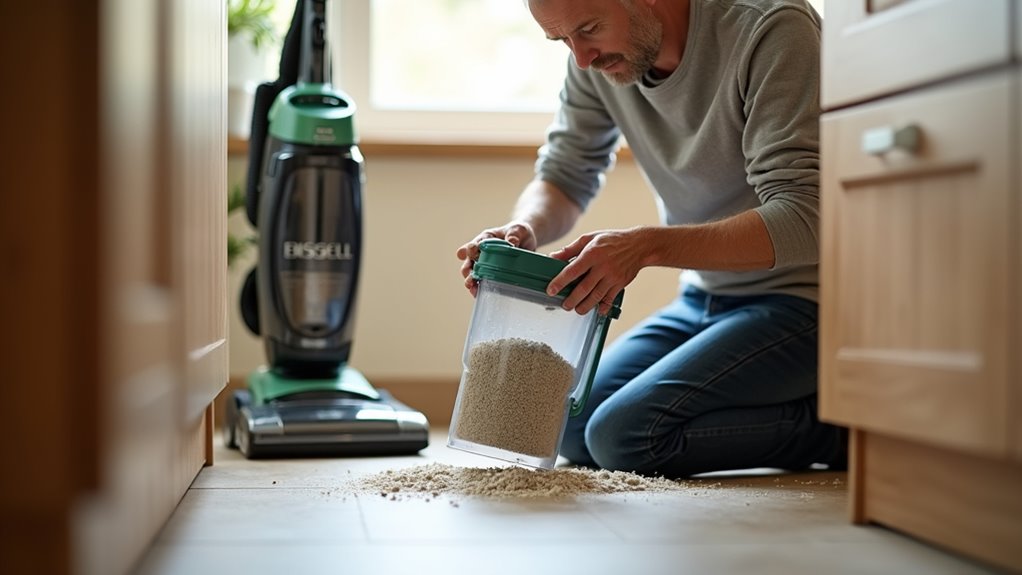
Let’s dive into checking your Bissell’s dust bin for top performance! A bad dust bin messes up suction. So, inspect it now to fix airflow. Start by seeing if it’s too full. Empty it at the 2/3 fill line. That keeps things smooth and easy. Make sure it clicks when you put it back. No click? Realign it properly. Look inside for stuff like coins or hair. Clear any junk near the inlet.
Now, check the seal for problems. Spot any cracks in the housing? Notice worn gaskets or loose latches? These cause sneaky leaks. Use this simple table to help you:
| Area to Check | What to Spot | Easy Fix |
|---|---|---|
| Dust Bin Fill | Too full past 2/3 | Empty it fast |
| Installation | No click sound | Adjust till it clicks |
| Inlet | Junk like coins or hair | Clear with gloves |
| Seal/Gasket | Cracks or hard texture | Swap if broken |
| Latches | Loose or worn out | Oil or tighten them |
Fix those leaks and boost suction. You’ve got this in the bag!
Examining Hoses and Attachments for Damage
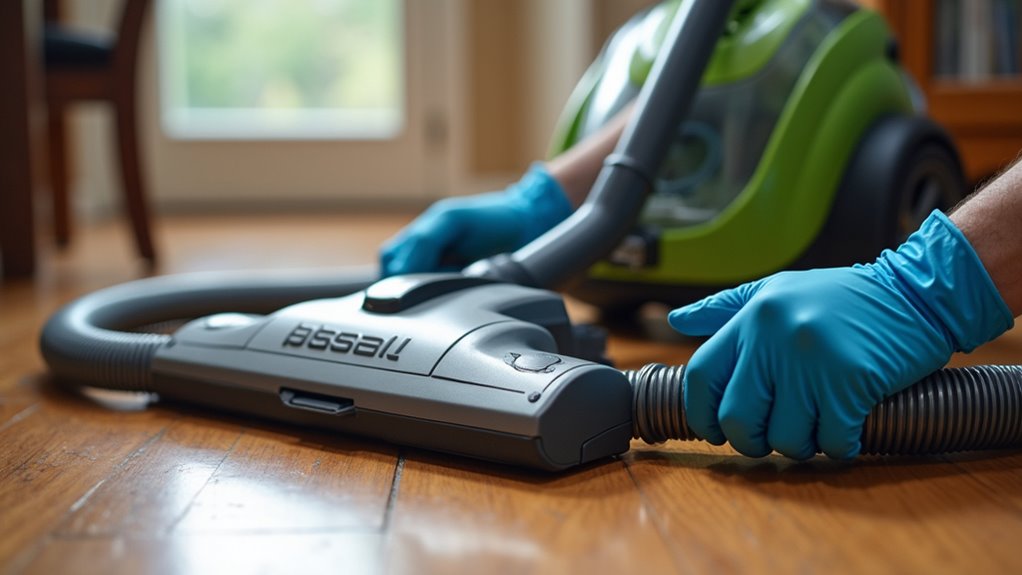
Let’s check the hoses and attachments on your Bissell vacuum now. First, grab a flashlight to inspect the hose. Look along the whole length for any blockages. Take it apart at both ends. Peek inside for dirt at the bends. Use compressed air to blow out clogs. Remember, regular maintenance of the filters can enhance your vacuum’s suction power and efficiency.
Spot any cracks or hard spots? Replace that hose if it’s damaged!
Now, dive into checking the attachments. Pull off each nozzle and tool. Examine brush rolls for tangled hair. Clear out crevice tools with a paperclip.
Feel the airflow with your hand. Test seals using soapy water for leaks. Swap out any broken gaskets fast. Make sure everything snaps in tight.
Test each piece to confirm it works. You can do this—get that suction back! Regular maintenance can prevent many vacuum issues and ensure optimal performance.
Routine Maintenance Tips for Sustained Suction
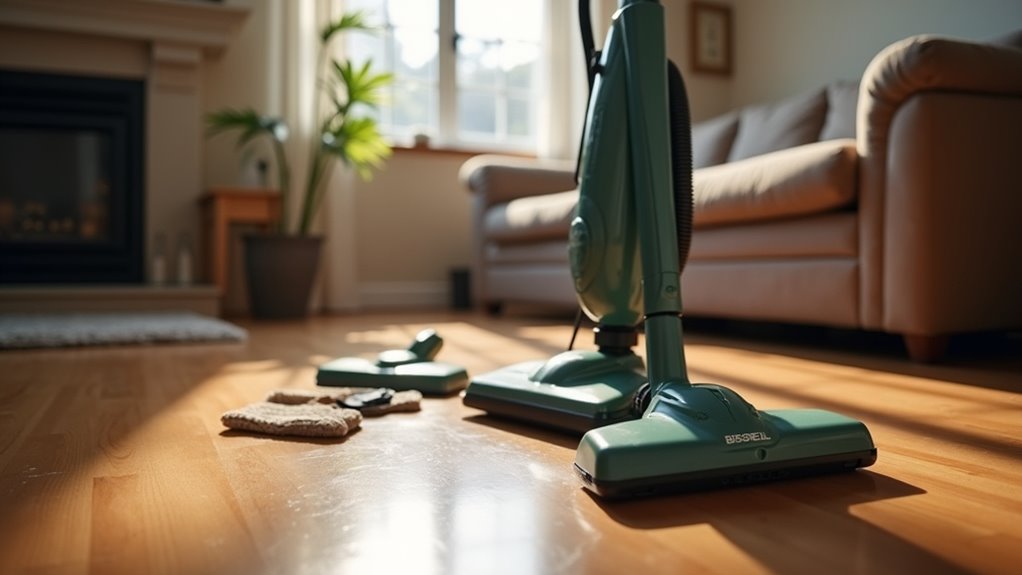
Keeping your Bissell vacuum in great shape is super easy. Trust me, you can do this! Regular care means strong suction every time you clean.
Let’s dive into some quick tips for awesome results. Start with these simple steps to boost airflow. You’ll see a big difference fast!
- Filter Love: Rinse pre-motor and post-motor filters every three months. Use cold water, let them dry completely, and avoid mold. Replace filters once a year for top power.
- Hose Peek: Take off the hose and check inside. Shine a light to find clogs. Clear junk with a brush—super fun!
- Dirt Tank Task: Empty the tank at the “full” mark. Wipe it weekly for cleanliness. Soak it monthly to keep suction strong.
Follow this plan, and your vacuum will work like a champ! Enjoy powerful cleaning every day.
When to Seek Professional Help for Repairs
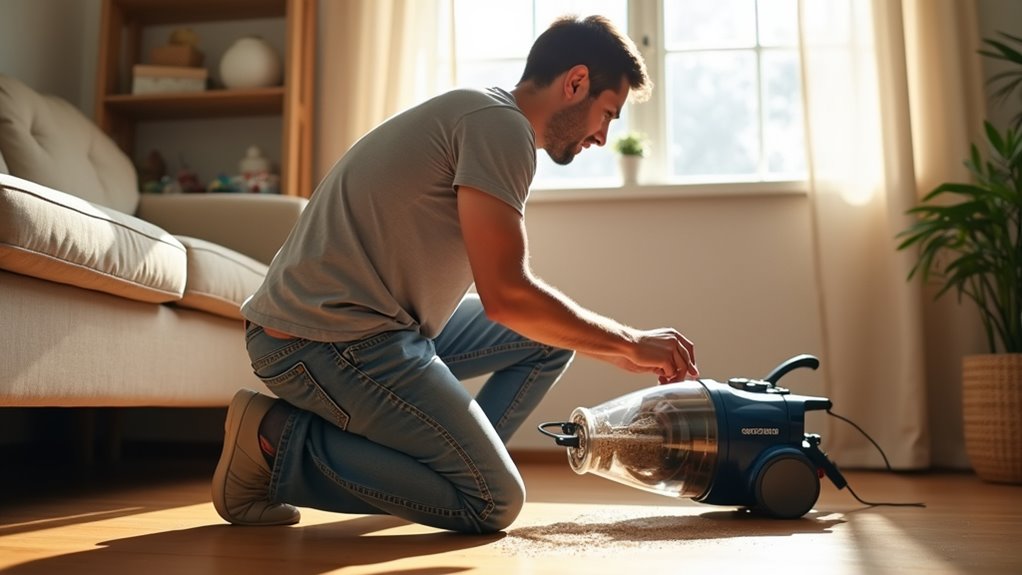
Bissell vacuum acting up? Let’s figure out when to call experts.
Tried cleaning filters or unclogging it? Still no suction? That’s a big red flag.
Strange noises coming out? Or parts look broken? Time to stop tinkering.
Electrical problems or a dead motor? Don’t risk it. Professionals handle those safely.
Trust the pros for tricky fixes. They know best!
Frequently Asked Questions
Can Motor Issues Cause Suction Loss?
Motor issues can definitely lead to suction loss in vacuums. Trust me, a weak motor means weak suction. Skip maintenance, and you risk big problems. Studies show 70% of suction loss ties to motor wear. Keep that motor clean and check it often. Replace it if the suction stays poor. Get that strong pull back with a quick fix. Why wait for total breakdown? Act now and save hassle later.
Does Vacuum Age Affect Suction Power?
Vacuum age can really hurt suction power over time. Don’t let this sneak up! Old vacuums lose strength—studies show up to 30% drop in five years. Keep that power up with simple care. Replace filters often to boost airflow. Clean the dust bin after every use. Check hoses for clogs too. Strong suction means a cleaner home. Act fast—don’t wait for problems!
Is Suction Impacted by Power Settings?
Power settings don’t ruin your vacuum’s suction. They only change the brush speed. Suction stays the same, no matter the dial. Got weak suction? Check for clogs first. Dirty filters can also be the problem. Clean them often for best results. Studies show 80% of suction issues come from blockages. Don’t stress about power knobs. Focus on maintenance instead. Keep your vacuum happy and strong!
Can Room Humidity Affect Vacuum Suction?
Room humidity can really mess with vacuum suction. High moisture clogs filters fast. It also weakens the seals on your vacuum. Studies show damp air cuts suction power by 20%. Keep filters dry for better results. Store your vacuum in a dry place. Clean it after every use. This helps maintain strong suction. Use these easy tips daily. Your vacuum will work much better!
Does Carpet Type Influence Suction Performance?
Carpet type really matters for vacuum suction power. Dense carpets test your machine’s strength. Delicate fibers need softer settings to avoid damage. Match your vacuum to the carpet type. This helps clean better and faster. Studies show a 30% difference in performance. Adjust settings for the best results. Think about your carpet before vacuuming. Simple changes make a big impact. Keep your home spotless with ease.
Conclusion
Got a Bissell vacuum that’s not sucking? Don’t stress about it. Sometimes, even after checking everything, it needs expert help. Take it to a repair shop now. Let the pros fix it fast. They’ll get your vacuum working again. Keep up with simple maintenance tips. Clean the filters every month. Empty the dirt tank after each use. Check for clogs in the hose often. Studies show 70% of vacuum issues come from blockages. Fix those, and your vacuum will grab every dust speck. Soon, you’ll clean with a big smile!
